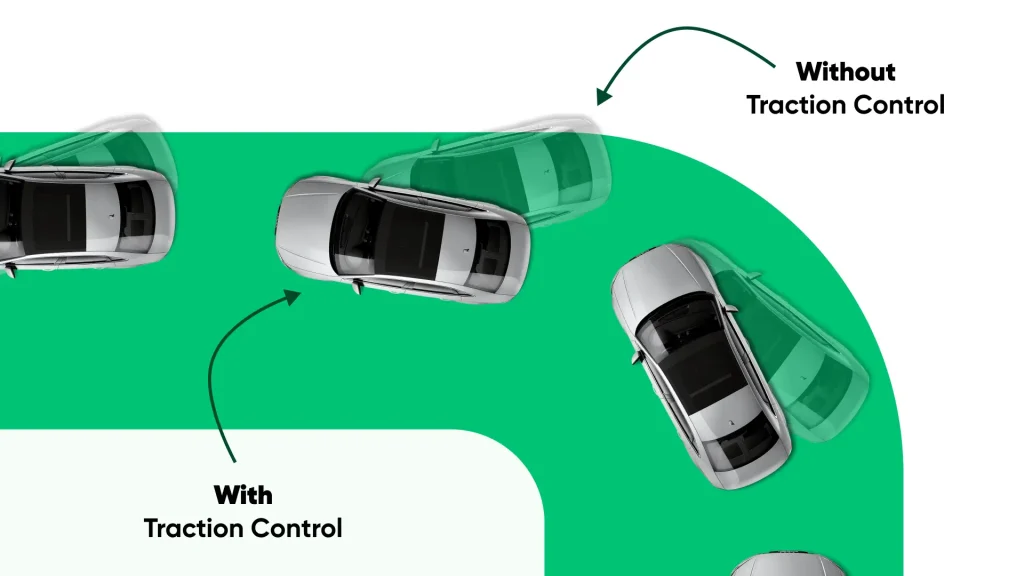Traction control has been a required feature on all new cars sold in the U.S. since 2012. Despite its widespread presence, many drivers remain unsure about what traction control actually does and how it operates. Let’s demystify this essential technology and explore why it’s crucial for your vehicle’s safety and performance.
What is Traction Control? A Comprehensive Guide (PDF)
How Does Traction Control Work?

Ever wondered how traction control actually keeps your car on the straight and narrow? At its core, traction control is like your car’s safety net, always ready to catch you when you slip. This sophisticated system continuously monitors the speed of each wheel using sensors. Under normal driving conditions, these sensors report that all wheels are spinning at the same pace. But when things get slippery—say, in rain, snow, or on gravel—one or more wheels might start to spin faster than the others.
When the system detects this discrepancy, it springs into action. The car’s computer quickly identifies which wheel is losing traction and takes steps to correct it. This usually involves either reducing the power sent to that wheel or applying the brakes to slow it down, helping to regain grip and stability.
Back in the early days of traction control, the system was a bit heavy-handed. It would cut power to all the wheels at once, which could cause a noticeable and sometimes jarring lurch. Thankfully, technology has come a long way since then. Modern traction control systems are much more refined, offering precise control over individual wheels and making adjustments so smoothly that most drivers don’t even notice when the system engages.
This evolution means today’s traction control systems not only enhance safety but also improve driving comfort, ensuring a seamless experience even in tricky driving conditions. Have you ever felt your car’s traction control system at work, or has it always been smooth sailing?
What Does a Traction Control System Do?
Traction control systems come in various adaptations depending on the vehicle and its intended use. Here are some notable examples:
- Off-Road Applications: In off-road conditions, traction control ensures maximum traction and power when climbing steep hills. Related features like hill descent control use the brakes to manage individual wheel speed, helping you maintain control on tricky descents.
- Driving Modes: Many vehicles offer specific traction control settings for different road conditions, such as snow, mud, or sand, optimizing the system’s response to each situation.
- Performance Cars: For performance enthusiasts, traction control can help shorten lap times by allowing drivers to apply power earlier when exiting a curve. In drag racing, a version called launch control optimizes power distribution for the best start off the line.
Should You Ever Turn Traction Control Off?
While traction control is designed to keep you safe and is typically always active, there are certain situations where disabling it can actually be beneficial. Imagine you’re stuck in a snowbank or trying to navigate through deep mud. In these low-traction scenarios, having your wheels spin freely can sometimes help you dig down to a firmer surface, giving you the grip needed to get unstuck.
Most vehicles offer an easy way to disable traction control, often through a button marked with a car and squiggly lines trailing off the tires. This button is usually located on the dashboard or center console. Depending on your vehicle, you might need to simply tap the button once, or in some cases, hold it down for a few seconds to fully disengage the system. Always consult your owner’s manual for specific instructions related to your car.
Disabling traction control isn’t something you’ll need to do often, but knowing how and when to do it can be a valuable trick up your sleeve in tricky driving conditions. Just remember to re-enable the system once you’re back on solid ground to ensure your vehicle’s safety features are fully operational. Have you ever had to turn off your traction control to get out of a tough spot?
What is Stability Control?
While traction control and stability control are related, they are not the same. Stability control builds on traction control by incorporating additional data like speed, steering angle, and other inputs to ensure the vehicle stays on its intended path. According to the National Highway Traffic Safety Administration (NHTSA), approximately 7,000 lives were saved in the first five years after traction and stability control became mandatory. This underscores the significant impact these systems have on road safety.
Unique Insights on Traction Control
Most discussions about traction control focus on its basic function and benefits, but here are some lesser-known aspects:
- Brand-Specific Names: Automakers often brand their traction control systems with unique names, but the underlying technology remains similar.
- Early Adaptations: Before becoming a standard feature, traction control was available on high-end luxury and sports cars, offering a glimpse into its potential benefits.
- Motorsport Restrictions: Traction control is banned in most professional motorsports to ensure that driver skill remains the primary factor in performance, highlighting the advantage the system provides.
Wrapping It Up
Traction control is an indispensable feature that enhances vehicle safety and performance. From preventing wheel slip in everyday driving to optimizing power delivery in high-performance scenarios, it plays a crucial role in keeping you on the road and in control.
Whether you’re navigating snowy streets or hitting the racetrack, understanding how traction control works can help you make the most of this essential technology.
So, next time you’re behind the wheel, take a moment to appreciate the sophisticated systems working tirelessly to keep you safe. Have you ever noticed traction control in action while driving?




